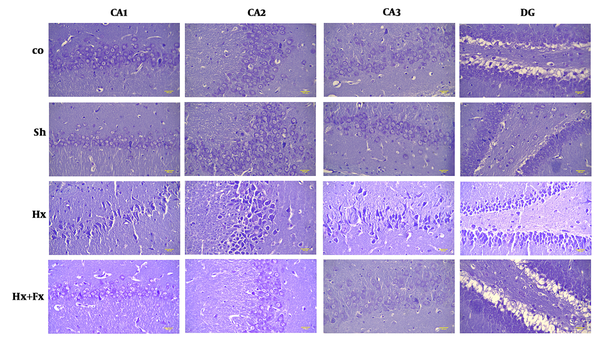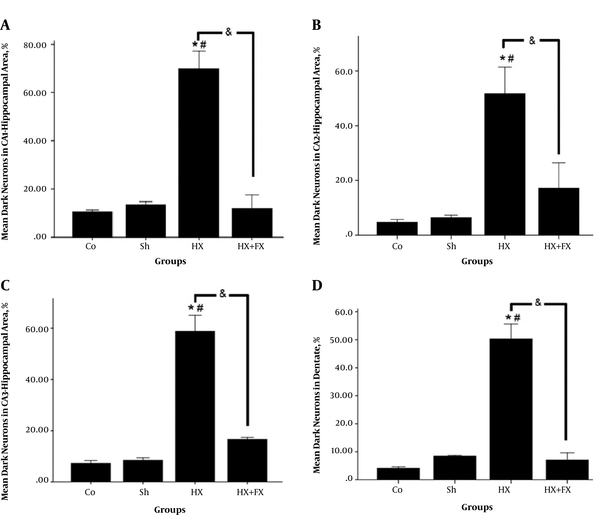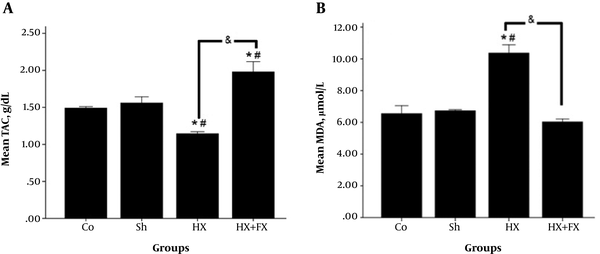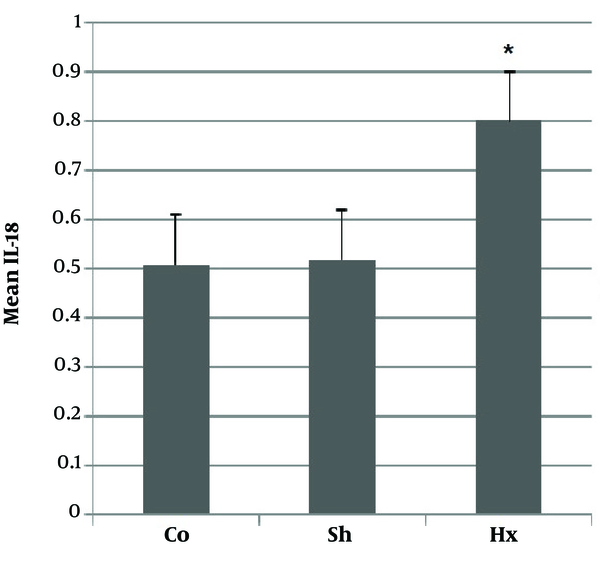Abstract
Background:
During hypoxia, the increased production of reactive oxygen species occurs during the re-oxygenation phase of periodic continuous hypobaric hypoxia.Objectives:
In this study, we surveyed the effect of supplementary flaxseed (Fx) on oxidative damage to the hippocampus of the hypoxic rat model.Methods:
In this study, 24 adult Wistar rats were randomly divided and studied in four groups: (1) The control group with normal oxygen and food (Co.), (2) The sham group placed in a hypoxia chamber with normal oxygen and food (Sh.), (3) Hypoxia induction group with normal food (Hx), and (4) Hypoxia induction group with 10% Fx food (Hx + Fx). Both the Hx and Hx + Fx groups were kept in a hypoxic chamber for 30 days while the atmospheric pressure was reduced (oxygen 8%, nitrogen 92%) for four hours daily. Malondialdehyde (MDA) and total antioxidant capacity (TAC) levels were evaluated in the hippocampus region of the brain tissue. Neuronal damage was examined using histological studies. Blood samples were collected to measure interleukin-18 (IL-18).Results:
A significant increase was recorded in the IL-18 level and hippocampal dark neurons of the CA1, CA2, CA3, and dentate gyrus (DG) areas in the Hx group as compared to Co. and Sh. groups (P < 0.05). Moreover, a significant decrease was noted in the dark neurons in the Hx + Fx group as compared to the Hx group (P < 0.05). A significant increase was observed in the TAC concentration in the Hx + Fx group in comparison with the Co., Sh., and Hx groups (P < 0.05), while a significant increase was observed in the MDA concentration in the Hx group as compared to the Co. and Sh. groups and a significant decrease in the Hx + Fx group as compared to the Hx group (P < 0.05).Conclusions:
This study suggested that the consumption of flaxseed could be a useful strategy for preventing the harmful effect of hypoxia on the hippocampus of the rat brain.Keywords
1. Background
Oxygen is vital for the development and growth of living organisms and low oxygen pressure conditions can cause hypoxia (1). The exposure of rats to hypobaric hypoxia for four weeks is the most common approach used to produce a systemic hypoxia, which stimulates the production of active oxygen species and reduces the number of enzymes, antioxidants, and lipid peroxidation (2). Increasing oxidative stress leads to morphological changes in the hippocampus (3, 4). The antioxidant agents help high rate cell survival by removing free radicals and dangerous compounds (5). Flax, scientifically named “Linum Usitatisimum”, is an herb containing polyunsaturated fatty acids (PUFA) (6, 7), so it is able to protect the brain in stroke models (8). Flaxseed (Fx) by neuroprotective effects can reduce the brain injury in hypoxia animal models (9, 10). Additionally, Fx is a good source of lignans, which is one of the major classes of phytoestrogens that have antioxidant properties to remove free radicals. Estrogen affects learning and memory in animal models and human studies and leads to increased dendritic thorn density in pyramidal neurons of the hippocampal region (11, 12). ALA is converted in the body into two types of fatty acids including eicosapentaenoic acid (EPA) and docosahexaenoic acid (DHA) (13). DHA has useful effects on preventing brain damage and functional outcomes (14).
Due to the effects of hypoxia on the brain tissue, especially the hippocampus region, and the neuroprotective effects of Fx on animal models, we investigated the effects of supplementary Fx on the hippocampus region of a rat model of hypoxia.
2. Methods
2.1. Experimental Design
In this study, 24 Wistar adult rats (body weight = 240 - 300 g) were kept under constant laboratory conditions and room temperature (20 - 22°C) and randomly divided into four (n = 6) experimental groups: Control (Co.), sham (Sh.), hypoxia (Hx), hypoxia + flaxseed (Hx + Fx).
Hypoxic rats were exposed to hypoxia (low oxygen pressure) by placing in a hypoxic chamber where the atmospheric pressure of oxygen was reduced (Oxygen 8%, Nitrogen 92%), 4 hours daily for 30 days. The hypoxic chamber was made of plexiglass equipped with a nitrogen gas inlet and a device controlling the oxygen pressure. During the four hours that the rats were in the chamber, a suitable amount of nitrogen gas entered the chamber as long as the oxygen control device showed the oxygen content of the chamber at 8%. The Co. group maintained in conditions of normoxia (oxygen 21%) and free access to normal food and water.
The Hx + Fx group was exposed to hypoxia four hours a day and fed with 10% Fx after the first hypoxic exposure for 6 weeks.
2.2. Preparation of Brain Sections
The rats were decapitated under anesthesia (80 mg/kg ketamine and 10 mg/kg xylazine) and the tissue was fixed by transcardial perfusion with 0.9% saline and kept in 4% paraformaldehyde in PBS. The brains were removed and cut down into five μm sections for H&E and Nissl staining. The sections were examined under a light microscope (Olympus, CX31, and Tokyo, Japan).
2.3. Cresyl Violet (Nissl) Staining
The dark neurons were visualized by staining for the histological samples of the brain injury with Nissl staining. Briefly, the brain was sectioned coronally with the thickness of 5 µm. The sections were stained with 0.04% Nissl staining dissolved in acetate buffer for 1 hour and dark neurons in the hippocampus were counted (15).
2.4. Cell Quantification
The cells were counted for each animal from the injured area (equivalent adult rat bregma coordinates -2.52 to -4.56 mm) in the dorsal part of the hippocampus cornu ammonis (CA1, CA2, and CA3 areas) and dentate gyrus (DG). The number of dark neurons counted was used as an index of cell death.
2.5. Tissue Preparation for Enzyme Assay
The hippocampus region of the rat brain was dissected, removed, and homogenized. The debris was removed by centrifugation at 3500 g for 10 minutes. The supernatant was collected to use for the estimation of the oxidative stress marker (Malondialdehyde (MDA)) and the antioxidant enzyme activity.
2.6. Evaluation of Brain Total Antioxidant Capacity (TAC) and Lipid Peroxidation
After removing and homogenizing the hippocampus, the debris was removed by centrifugation at 3500 g for 10 minutes. The supernatant was collected and 50 mg of the supernatant was homogenized again in 10 volumes of a buffer (solution PBS) and centrifuged. The supernatant was collected and used for enzymatic studies.
2.7. IL-18 Demonstrations
After the induction of hypoxia, blood samples were collected and centrifuged for 10 minutes at 20000 rpm to separate plasma for biochemical analysis of interleukin (IL). IL-18 was determined in the serum by using the enzyme-linked immunoabsorbent assay (ELISA) and Kit (Zell Bio-GmbH) according to the instruction of the manufacturer.
2.8. Data Analysis
Statistical analysis was performed via one-way analysis of variance (ANOVA) and the post hoc Tukey and Tamhane T2 tests using SPSS 16 and P < 0.05 was considered significant.
3. Results
3.1. Fx Effects on Neuronal Density and Dead Neurons in the Hippocampus of Hypoxic Rats
In the hypoxic group, the number of dark cells in the hippocampus significantly increased as compared to the control group (P < 0.05) (Figure 1). In the Fx + Hx group, the number of dark neurons in the hippocampus significantly decreased after 6 weeks (P < 0.05). No significant differences were observed between the control and sham groups with respect to the number of dark cells in any of the tested brain regions (Figure 2).
Effects of Fx supplementation on histological changes in the hippocampus of rats with hypoxia. Histological changes in the hippocampus of rats during hypoxia induction and the effect of flaxseed on the histopathology of different areas of the hippocampus (Cresyl Violet (Nissl) staining, X400). Hypoxia leads to disturbed neuronal density in different areas of the hippocampus and significant improvements were observed in the Hx + Fx group. Co = control, Sh = sham, Hx = hypoxia, Hx + Fx = hypoxia treatment with flaxseed.

Effects of Fx on the number of dark neurons in different regions of the hippocampus in rats with hypoxia. A, CA1; B, CA; C, CA3; and D, DG. * = compared to Co. group; # = compared to Sh. group; & = compared two groups of Hx and Hx + Fx. Co = control, Sh = sham, Hx = hypoxia, Hx + Fx = hypoxia treatment with flaxseed.

3.2. Fx Effects on TAC and MDA in the Hippocampal Region of Hypoxic Rats
A significant increase (P < 0.05) was observed in the TAC concentration of the Hx + Fx group in comparison with the other groups (Figure 3).
Effects of Fx on the stress oxidative factors of the hippocampus in rats with hypoxia. A, TAC concentration was significantly different so that a significant increase was observed in TAC concentration in the treatment group in comparison with the other groups (P < 0.05); B, the mean MDA concentration significantly increased in the Hx group compared to the Co. and Sh. groups. There is also a significant difference with the Hx + Fx group (P < 0.05). * = compared to Co. group; # = compared to Sh. group; & = compared two groups of Hx and Hx + Fx. and Sh. groups. Co = control, Sh = sham, Hx = hypoxia, Hx + Fx= hypoxia treatment with flaxseed.

3.3. Evaluation of IL-18
Pro-inflammatory cytokine IL-18 was evaluated in the sera for confirming the model of hypoxia. In comparison with the control and sham groups, the Hx group showed a significant rise (P < 0.05) in the level of IL-18 after hypoxia (Figure 4).
The changes in the serum IL-18 levels of rats after induction of hypoxia, showing a significant rise in the level of IL-18 in the Hx group compared to Co. and Sh. groups *. Co = control, Sh = sham, Hx = hypoxia.

3.4. Correlation Between Numerical Data
According to Table 1, a significant correlation was observed between the amount TAC and the number of dark neurons in the different regions of the hippocampus so that an increase in the number of dark neurons was associated with a decline in TAC (Figure 5). There was a significant correlation between the MDA level and the number of dark neurons in the hippocampus so that with an increase in the number of dark neurons, the MDA level increased (Table 1, Figure 6).
The Effects of Oral Fx on TAC and MDA Concentrations
| Hippocampal Areas | TAC (g/dL) | MDA (μmol/L) |
|---|---|---|
| Dark neurons in CA1 (%) | ||
| r | -0.792 | 0.982 |
| P value | 0.004 | 0.000 |
| Dark neurons in CA2 (%) | ||
| r | -0.618 | 0.888 |
| P value | 0.043 | 0.000 |
| Dark neurons in CA3 (%) | ||
| r | -0.675 | 0.948 |
| P value | 0.032 | 0.000 |
| Dark neurons in DG (%) | ||
| r | -0.758 | 0.972 |
| P value | 0.011 | 0.000 |
Correlation between numerical data of TAC and number of dark neurons in different areas of the hippocampus following treatment with Fx in rats with hypoxia. By increasing the number of dark neurons in different areas of the hippocampus, A, CA1; B, CA; C, CA3; D, DG, the TAC amount decreased.

Correlation between numerical data of MDA and number of dark neurons in different areas of the hippocampus following treatment with Fx in rats with hypoxia. A significant correlation was observed between the amount MDA and the number of dark neurons in different regions of the hippocampus, A, CA1; B, CA; C, CA3 and D, DG, and with an increase in the number of dark neurons, the MDA level increased.

4. Discussion
In this study, we evaluated the neuroprotective effects of Fx in the rat hippocampus subjected to hypoxia. Our results indicated that the Fx consumption in hypoxic rats could increase neuroprotection against a hypoxic injury.
In the central nervous system, an injury caused by hypoxia extends the spectrum of cognitive impairments (16-18). Inflammation is a critical factor in the development of hypoxia in the brain and the production of pro-inflammatory cytokines like IL-18 occurs in the hypoxia. Hedtjarn et al. (19), found that IL-18 markedly increased after hypoxia suggesting that it is important for the development of HI brain injury. Some investigations confirmed that the generation of reactive oxygen species and the subsequent oxidative stress have harmful effects in perinatal brain hypoxia (20-23). The brain is one of the most sensitive regions in response to oxidative damage (24, 25). Lievre et al. found out that the neuronal generation of ROS increased after transient hypoxia (26).
In the present study, Fx was used to decrease the effects of hypoxia in rats. Fx is one of the richest sources of n-3 PUFA acid and α-linolenic acid (27, 28). Some studies reported that Fx exerts anti-inflammatory effects and the important anti-atherogenic property of ALA may have a potent anti-inflammatory role (29, 30). Nounou et al. reported that Fx is one of the promising cytoprotective factors for increasing defense mechanisms in the physiological systems against oxidative stress (31). Lots of evidence indicated that polyunsaturated fatty acids, like docosahexaenoic acid (DHA), improved brain injury (32-34). DHA maintains neurons and reduces cerebral damage at the level of the middle hippocampus (35, 36). Studies have shown that a low dietary consumption of FA or low plasma DHA concentration is associated with impaired neurogenesis (37-39). In a study by Mokhtari et al. (28), the neuroprotective effects of Fx oil on the functional motor recovery were evaluated in a model of ischemic brain stroke. They showed that Fx could protect the cortex against ischemic stroke by upregulation of the brain-derived neurotrophic factor (BDNF) and glial cell-derived neurotrophic factor (GDNF) (28).
DHA is cleaved from the membrane phospholipids to free DHA during brain ischemia and reperfusion (I/R) (40-42). Although DHA up-regulates the Bcl-2 family, it down-regulates caspase-3 (41, 43, 44). During hypoxia, the production of reactive oxygen species increases in addition to the protective ability of the cells, which activate lipid peroxidation (45, 46). Pan et al. (47) found that chronic administration of (DHA) could reduce MDA levels. Our results showed that the mean number of dark neurons was high in the hippocampus region following hypoxia. Moreover, the number of dark pyramidal neurons reduced in the treatment group in comparison with the hypoxic group. In this study, we found that there was a significant change in the level of TAC and lipid peroxidation in the treatment group as compared to the hypoxia group in the hippocampus region.
4.1. Conclusions
The findings of the current study confirmed the greater survival of hippocampal neurons in flaxseed treated animals and provided an evidence to stimulate the clinical development of flaxseed for use as effective therapy in hypoxic brains in order to reduce the cognitive impairment.
References
-
1.
Farias JG, Puebla M, Acevedo A, Tapia PJ, Gutierrez E, Zepeda A, et al. Oxidative stress in rat testis and epididymis under intermittent hypobaric hypoxia: protective role of ascorbate supplementation. J Androl. 2010;31(3):314-21. [PubMed ID: 20378932]. https://doi.org/10.2164/jandrol.108.007054.
-
2.
Brock M, Haider TJ, Vogel J, Gassmann M, Speich R, Trenkmann M, et al. The hypoxia-induced microRNA-130a controls pulmonary smooth muscle cell proliferation by directly targeting CDKN1A. Int J Biochem Cell Biol. 2015;61:129-37. [PubMed ID: 25681685]. https://doi.org/10.1016/j.biocel.2015.02.002.
-
3.
Catassi A, Servent D, Paleari L, Cesario A, Russo P. Multiple roles of nicotine on cell proliferation and inhibition of apoptosis: implications on lung carcinogenesis. Mutat Res. 2008;659(3):221-31. [PubMed ID: 18495523]. https://doi.org/10.1016/j.mrrev.2008.04.002.
-
4.
Bergstrom HC, McDonald CG, French HT, Smith RF. Continuous nicotine administration produces selective, age-dependent structural alteration of pyramidal neurons from prelimbic cortex. Synapse. 2008;62(1):31-9. [PubMed ID: 17957736]. https://doi.org/10.1002/syn.20467.
-
5.
Miura S, Ishida-Nakajima W, Ishida A, Kawamura M, Ohmura A, Oguma R, et al. Ascorbic acid protects the newborn rat brain from hypoxic-ischemia. Brain Dev. 2009;31(4):307-17. [PubMed ID: 18682317]. https://doi.org/10.1016/j.braindev.2008.06.010.
-
6.
Eichenbaum H. Hippocampus: cognitive processes and neural representations that underlie declarative memory. Neuron. 2004;44(1):109-20. [PubMed ID: 15450164]. https://doi.org/10.1016/j.neuron.2004.08.028.
-
7.
Pham-Huy LA, He H, Pham-Huy C. Free radicals, antioxidants in disease and health. Int J Biomed Sci. 2008;4(2):89-96. [PubMed ID: 23675073]. [PubMed Central ID: PMC3614697].
-
8.
da Cunha J, Macedo da Costa TH, Ito MK. Influences of maternal dietary intake and suckling on breast milk lipid and fatty acid composition in low-income women from Brasilia, Brazil. Early Hum Dev. 2005;81(3):303-11. [PubMed ID: 15814213]. https://doi.org/10.1016/j.earlhumdev.2004.08.004.
-
9.
Zhang W, Hu X, Yang W, Gao Y, Chen J. Omega-3 polyunsaturated fatty acid supplementation confers long-term neuroprotection against neonatal hypoxic-ischemic brain injury through anti-inflammatory actions. Stroke. 2010;41(10):2341-7. [PubMed ID: 20705927]. [PubMed Central ID: PMC3021248]. https://doi.org/10.1161/STROKEAHA.110.586081.
-
10.
Gholaminejhad M, Arabzadeh S, Akbari M, Mohamadi Y, Hassanzadeh G. Anti-oxidative and neuroprotective effects of flaxseed on experimental unilateral spinal cord injury in rat. J Contemp Med Sci. 2017;3(10):213-7. https://doi.org/10.22317/jcms.06201703.
-
11.
Kittur S, Wilasrusmee S, Pedersen WA, Mattson MP, Straube-West K, Wilasrusmee C, et al. Neurotrophic and Neuroprotective effects of milk thistle (silybum marianum)on neurons in culture. J Mol Neurosci. 2002;18(3):265-70. https://doi.org/10.1385/jmn:18:3:265.
-
12.
Wang MJ, Lin WW, Chen HL, Chang YH, Ou HC, Kuo JS, et al. Silymarin protects dopaminergic neurons against lipopolysaccharide-induced neurotoxicity by inhibiting microglia activation. Eur J Neurosci. 2002;16(11):2103-12. [PubMed ID: 12473078].
-
13.
Diamond DA. Adolescent varicocele: emerging understanding. BJU Int. 2003;92 Suppl 1:48-51. [PubMed ID: 12969010].
-
14.
Mucci Dde B, Fernandes FS, Souza Ados S, Sardinha FL, Soares-Mota M, Tavares do Carmo M. Flaxseed mitigates brain mass loss, improving motor hyperactivity and spatial memory, in a rodent model of neonatal hypoxic-ischemic encephalopathy. Prostaglandins Leukot Essent Fatty Acids. 2015;97:13-9. [PubMed ID: 25865679]. https://doi.org/10.1016/j.plefa.2015.03.001.
-
15.
Atlasi MA, Naderian H, Noureddini M, Fakharian E, Azami A. Morphology of Rat Hippocampal CA1 Neurons Following Modified Two and Four-Vessels Global Ischemia Models. Arch Trauma Res. 2013;2(3):124-8. [PubMed ID: 24693522]. [PubMed Central ID: PMC3950915]. https://doi.org/10.5812/atr.10240.
-
16.
Back SA. Cerebral white and gray matter injury in newborns: new insights into pathophysiology and management. Clin Perinatol. 2014;41(1):1-24. [PubMed ID: 24524444]. [PubMed Central ID: PMC3947650]. https://doi.org/10.1016/j.clp.2013.11.001.
-
17.
Logitharajah P, Rutherford MA, Cowan FM. Hypoxic-ischemic encephalopathy in preterm infants: antecedent factors, brain imaging, and outcome. Pediatr Res. 2009;66(2):222-9. [PubMed ID: 19390490]. https://doi.org/10.1203/PDR.0b013e3181a9ef34.
-
18.
Perez A, Ritter S, Brotschi B, Werner H, Caflisch J, Martin E, et al. Long-term neurodevelopmental outcome with hypoxic-ischemic encephalopathy. J Pediatr. 2013;163(2):454-9. [PubMed ID: 23498155]. https://doi.org/10.1016/j.jpeds.2013.02.003.
-
19.
Hedtjarn M, Leverin AL, Eriksson K, Blomgren K, Mallard C, Hagberg H. Interleukin-18 involvement in hypoxic-ischemic brain injury. J Neurosci. 2002;22(14):5910-9. [PubMed ID: 12122053].
-
20.
Daval JL, Ghersi-Egea JF, Oillet J, Koziel V. A simple method for evaluation of superoxide radical production in neural cells under various culture conditions: application to hypoxia. J Cereb Blood Flow Metab. 1995;15(1):71-7. [PubMed ID: 7798340]. https://doi.org/10.1038/jcbfm.1995.8.
-
21.
Maulik D, Numagami Y, Ohnishi ST, Mishra OP, Delivoria-Papadopoulos M. Direct measurement of oxygen free radicals during in utero hypoxia in the fetal guinea pig brain. Brain Res. 1998;798(1-2):166-72. https://doi.org/10.1016/s0006-8993(98)00408-9.
-
22.
Mishra OP, Delivoria-Papadopoulos M. Cellular mechanisms of hypoxic injury in the developing brain. Brain Res Bull. 1999;48(3):233-8. https://doi.org/10.1016/s0361-9230(98)00170-1.
-
23.
Pourcyrous M, Leffler CW, Bada HS, Korones SB, Busija DW. Brain superoxide anion generation in asphyxiated piglets and the effect of indomethacin at therapeutic dose. Pediatr Res. 1993;34(3):366-9. [PubMed ID: 8134180]. https://doi.org/10.1203/00006450-199309000-00025.
-
24.
Mishra OP, Delivoria-Papadopoulos M. Anti-oxidant enzymes in fetal guinea pig brain during development and the effect of maternal hypoxia. Dev Brain Res. 1988;42(2):173-9. https://doi.org/10.1016/0165-3806(88)90235-0.
-
25.
Mover H, Ar A. Antioxidant enzymatic activity in embryos and placenta of rats chronically exposed to hypoxia and hyperoxia. Comp Biochem Physiol: Pharmacol Toxicol Endocrinol. 1997;117(2):151-7. https://doi.org/10.1016/s0742-8413(97)00062-5.
-
26.
Lievre V, Becuwe P, Bianchi A, Bossenmeyer-Pourie C, Koziel V, Franck P, et al. Intracellular generation of free radicals and modifications of detoxifying enzymes in cultured neurons from the developing rat forebrain in response to transient hypoxia. Neuroscience. 2001;105(2):287-97. [PubMed ID: 11672596].
-
27.
Carotenuto F, Costa A, Albertini MC, Rocchi MB, Rudov A, Coletti D, et al. Dietary Flaxseed Mitigates Impaired Skeletal Muscle Regeneration: in Vivo, in Vitro and in Silico Studies. Int J Med Sci. 2016;13(3):206-19. [PubMed ID: 26941581]. [PubMed Central ID: PMC4773285]. https://doi.org/10.7150/ijms.13268.
-
28.
Mokhtari T, Faghir Ghanesefat H, Hassanzadeh G, Moayeri A, Haeri SMJ, Rezaee Kanavee A, et al. Effects of flaxseed oil supplementation on renal dysfunction due to ischemia/reperfusion in rat. J Basic Res Med Sci. 2017;4(1):22-9. https://doi.org/10.18869/acadpub.jbrms.4.1.22.
-
29.
Calder PC. Polyunsaturated fatty acids, inflammation, and immunity. Lipids. 2001;36(9):1007-24. [PubMed ID: 11724453].
-
30.
Rodriguez-Leyva D, Bassett CMC, McCullough R, Pierce GN. The cardiovascular effects of flaxseed and its omega-3 fatty acid, alpha-linolenic acid. Can J Cardiol. 2010;26(9):489-96. https://doi.org/10.1016/s0828-282x(10)70455-4.
-
31.
Nounou HA, Deif MM, Shalaby MA. Effect of flaxseed supplementation and exercise training on lipid profile, oxidative stress and inflammation in rats with myocardial ischemia. Lipids Health Dis. 2012;11:129. [PubMed ID: 23036047]. [PubMed Central ID: PMC3508923]. https://doi.org/10.1186/1476-511X-11-129.
-
32.
Keen CL, Lonnerdal B, Clegg M, Hurley LS. Developmental changes in composition of rat milk: trace elements, minerals, protein, carbohydrate and fat. J Nutr. 1981;111(2):226-36. [PubMed ID: 7463167]. https://doi.org/10.1093/jn/111.2.226.
-
33.
Reeves PG, Nielsen FH, Fahey GC Jr. AIN-93 purified diets for laboratory rodents: final report of the American Institute of Nutrition ad hoc writing committee on the reformulation of the AIN-76A rodent diet. J Nutr. 1993;123(11):1939-51. [PubMed ID: 8229312]. https://doi.org/10.1093/jn/123.11.1939.
-
34.
Vannucci RC, Connor JR, Mauger DT, Palmer C, Smith MB, Towfighi J, et al. Rat model of perinatal hypoxic-ischemic brain damage. J Neurosci Res. 1999;55(2):158-63. [PubMed ID: 9972818]. https://doi.org/10.1002/(SICI)1097-4547(19990115)55:2<158::AID-JNR3>3.0.CO;2-1.
-
35.
Arteaga O, Revuelta M, Urigüen L, Martínez-Millán L, Hilario E, Álvarez A. Docosahexaenoic acid reduces cerebral damage and ameliorates long-term cognitive impairments caused by neonatal hypoxia–ischemia in rats. Mol Neurobiol. 2017;54(9):7137-55.
-
36.
Berman DR, Mozurkewich E, Liu Y, Barks J. Docosahexaenoic acid pretreatment confers neuroprotection in a rat model of perinatal cerebral hypoxia-ischemia. Am J Obstet Gynecol. 2009;200(3):305 e1-6. [PubMed ID: 19254588]. [PubMed Central ID: PMC2824338]. https://doi.org/10.1016/j.ajog.2009.01.020.
-
37.
Heinrichs SC. Dietary omega-3 fatty acid supplementation for optimizing neuronal structure and function. Mol Nutr Food Res. 2010;54(4):447-56. [PubMed ID: 20112300]. https://doi.org/10.1002/mnfr.200900201.
-
38.
Innis SM. Dietary omega 3 fatty acids and the developing brain. Brain Res. 2008;1237:35-43. [PubMed ID: 18789910]. https://doi.org/10.1016/j.brainres.2008.08.078.
-
39.
Kitajka K, Sinclair AJ, Weisinger RS, Weisinger HS, Mathai M, Jayasooriya AP, et al. Effects of dietary omega-3 polyunsaturated fatty acids on brain gene expression. Proc Natl Acad Sci U S A. 2004;101(30):10931-6. [PubMed ID: 15263092]. [PubMed Central ID: PMC503722]. https://doi.org/10.1073/pnas.0402342101.
-
40.
Belayev L, Marcheselli VL, Khoutorova L, Rodriguez de Turco EB, Busto R, Ginsberg MD, et al. Docosahexaenoic acid complexed to albumin elicits high-grade ischemic neuroprotection. Stroke. 2005;36(1):118-23. [PubMed ID: 15569878]. https://doi.org/10.1161/01.STR.0000149620.74770.2e.
-
41.
Lukiw WJ, Cui JG, Marcheselli VL, Bodker M, Botkjaer A, Gotlinger K, et al. A role for docosahexaenoic acid-derived neuroprotectin D1 in neural cell survival and Alzheimer disease. J Clin Invest. 2005;115(10):2774-83. [PubMed ID: 16151530]. [PubMed Central ID: PMC1199531]. https://doi.org/10.1172/JCI25420.
-
42.
Marcheselli VL, Hong S, Lukiw WJ, Tian XH, Gronert K, Musto A, et al. Novel docosanoids inhibit brain ischemia-reperfusion-mediated leukocyte infiltration and pro-inflammatory gene expression. J Biol Chem. 2003;278(44):43807-17. [PubMed ID: 12923200]. https://doi.org/10.1074/jbc.M305841200.
-
43.
Bazan NG. Neuroprotectin D1-mediated anti-inflammatory and survival signaling in stroke, retinal degenerations, and Alzheimer's disease. J Lipid Res. 2009;50 Suppl:S400-5. [PubMed ID: 19018037]. [PubMed Central ID: PMC2674685]. https://doi.org/10.1194/jlr.R800068-JLR200.
-
44.
Lukiw WJ, Bazan NG. Docosahexaenoic acid and the aging brain. J Nutr. 2008;138(12):2510-4. [PubMed ID: 19022980]. [PubMed Central ID: PMC2666388]. https://doi.org/10.3945/jn.108.096016.
-
45.
Johnston MV, Trescher WH, Ishida A, Nakajima W. Neurobiology of hypoxic-ischemic injury in the developing brain. Pediatr Res. 2001;49(6):735-41. [PubMed ID: 11385130]. https://doi.org/10.1203/00006450-200106000-00003.
-
46.
Perlman JM. Pathogenesis of hypoxic-ischemic brain injury. J Perinatol. 2007;27(S1):S39-46. https://doi.org/10.1038/sj.jp.7211716.
-
47.
Pan HC, Kao TK, Ou YC, Yang DY, Yen YJ, Wang CC, et al. Protective effect of docosahexaenoic acid against brain injury in ischemic rats. J Nutr Biochem. 2009;20(9):715-25. [PubMed ID: 18805685]. https://doi.org/10.1016/j.jnutbio.2008.06.014.

